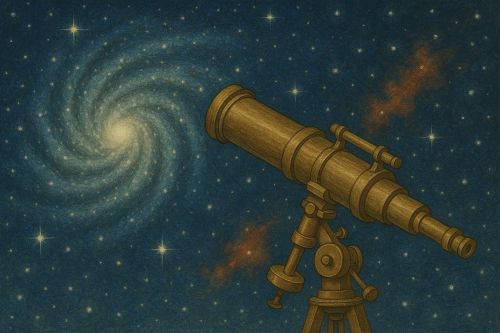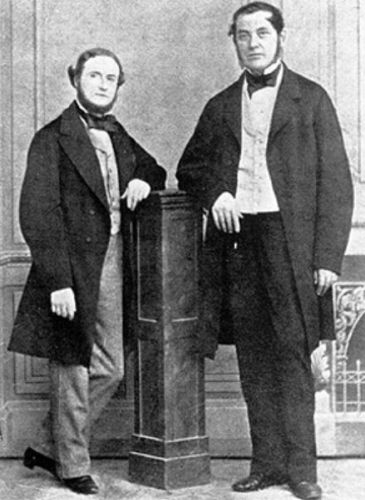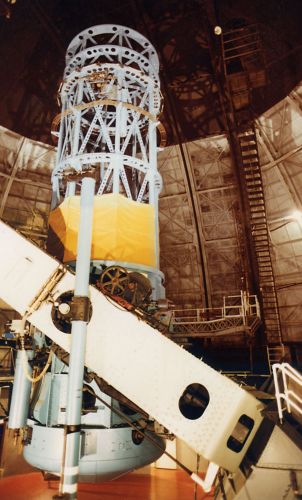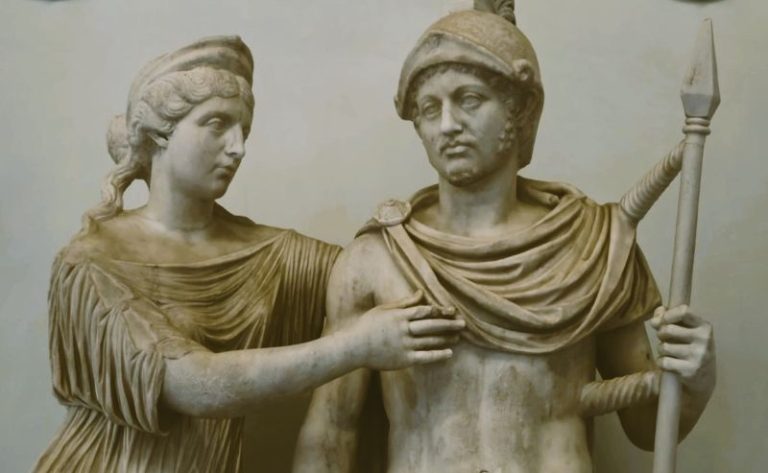

The history of modern astrophysics is, in many ways, the history of a deepening intimacy with the cosmos, to the enduring human desire to situate ourselves within a cosmic narrative.

By Matthew A. McIntosh
Public Historian
Brewminate
The 19th Century Foundations of Astrophysics
Overview
In the early decades of the nineteenth century, astronomy still bore the imprint of its classical and Enlightenment inheritance. Its central task remained the mapping of celestial positions and the calculation of orbital mechanics. Telescopes, though vastly improved from Galileo’s crude refractor, were still employed largely for visual observation. The heavens were measured and charted, but their physical nature remained a matter for speculation rather than experimental investigation. The very term “astrophysics” was scarcely in circulation.1
It was the fusion of physics with astronomical observation that redefined the discipline. The emergence of thermodynamics, electromagnetism, and spectroscopy in the mid-century created an unprecedented bridge between the physical sciences and the night sky. This intellectual convergence made it possible to treat stars not merely as points of light but as physical bodies governed by the same laws of matter and energy that applied on Earth.2
Spectroscopy and the Chemical Cosmos

The invention of the spectroscope in the 1850s by Gustav Kirchhoff and Robert Bunsen marked a decisive turning point.3 By analyzing the absorption and emission lines in stellar spectra, astronomers could determine the chemical composition of distant suns. The revelation that the same elements found on Earth were present throughout the cosmos dismantled the Aristotelian notion of celestial incorruptibility.
This new technique did more than catalogue elements. It provided the first quantitative means of probing stellar atmospheres, temperatures, and motions. Spectral analysis allowed William Huggins in England to determine that certain nebulae were composed of glowing gas rather than unresolved stars.4 It also revealed the Doppler shifts in stellar lines, enabling the measurement of radial velocities across vast distances. For the first time, the motions of stars could be traced not just across the sky, but toward and away from the observer.
The Rise of Stellar Physics
Spectroscopy did not stand alone. The application of thermodynamic principles to the problem of stellar energy challenged older explanations, such as the Kelvin–Helmholtz contraction hypothesis, which suggested that the Sun’s heat came from gravitational contraction. By the late nineteenth century, the realization that such a mechanism could only sustain solar radiation for tens of millions of years clashed with the geological evidence for an Earth billions of years old.5
Speculations about nuclear processes began to surface, though the full mechanism of fusion would not be demonstrated until the twentieth century. Nonetheless, the combination of observational data and physical theory had shifted astronomy into a new register: it was no longer content with describing where celestial bodies were, but sought to understand what they were and how they evolved.
The Observatory as Laboratory
By the 1890s, leading observatories such as Lick, Yerkes, and the Royal Greenwich were no longer merely “watchtowers” of the heavens but functioned as experimental laboratories.6 Precision instruments recorded spectra photographically, freeing astronomers from the limitations of human vision and enabling the accumulation of massive data sets. Astrophysics emerged as a profession, with dedicated chairs and journals, distinct from the older tradition of positional astronomy.
The transformation was not without resistance. Some traditionalists regarded the influx of physical theory as a distraction from the practical tasks of charting and predicting celestial motions.7 Yet the momentum was irreversible. By the dawn of the twentieth century, astronomy had been irrevocably transformed into a physical science, poised to address questions that would have seemed speculative fantasy only a century earlier.
Expanding Horizons: Astrophysics in the Twentieth Century
Overview
The transition into the twentieth century marked not merely a continuation of the previous century’s methods, but a dramatic expansion in both scale and ambition. The foundational achievements of spectroscopy, celestial mechanics, and thermodynamics had opened new avenues of inquiry, yet many of the central questions of astrophysics remained unanswered. It was in this century that the discipline would be revolutionized by advances in quantum theory, relativity, and instrumentation, producing a cosmology more comprehensive—and more unsettling—than anything previously imagined.8
Einstein, Relativity, and the Shape of Space

In 1915, Albert Einstein presented his general theory of relativity, replacing Newton’s conception of gravity as a force acting across space with the idea of spacetime curvature. Gravity, in this view, was not a pull but the manifestation of mass bending the very geometry of the cosmos.9 The implications for astrophysics were profound: the trajectories of planets, the bending of light by gravity, and even the large-scale structure of the universe could now be described within a single theoretical framework.
Relativity did not displace Newtonian mechanics in practical astronomy overnight. For most solar system calculations, the older theory remained sufficient. Yet, in 1919, Arthur Eddington’s famous expedition to observe the solar eclipse confirmed Einstein’s prediction that starlight would bend in the Sun’s gravitational field.10 This was more than an experimental victory; it signaled that astrophysics was now engaged with the very fabric of space and time, a domain that classical astronomy had never attempted to chart.
Quantum Theory and the Lives of Stars
While relativity reshaped the stage on which the cosmos unfolded, quantum mechanics transformed the understanding of what occurred upon it. Niels Bohr, Arnold Sommerfeld, and later Werner Heisenberg and Erwin Schrödinger provided the framework for understanding atomic structure and radiation, making it possible to calculate stellar spectra with unprecedented precision.11
The new physics also allowed a deeper comprehension of stellar interiors. Subrahmanyan Chandrasekhar’s work on white dwarfs revealed that quantum degeneracy pressure, an effect arising from the Pauli exclusion principle, prevented the collapse of these stellar remnants below a certain mass limit.12 Above this “Chandrasekhar limit,” stars would continue to collapse into neutron stars or black holes. The once-poetic notion of stellar death had been rendered into a rigorous physical taxonomy, complete with quantitative thresholds.
The Expansion of the Universe

In the 1920s, Edwin Hubble, working with the 100-inch Hooker Telescope at Mount Wilson Observatory, established that the “spiral nebulae” were not clouds within our galaxy, but separate galaxies altogether.13 By measuring the redshifts in their spectra, Hubble demonstrated that these galaxies were receding from us, implying that the universe itself was expanding. The discovery was quickly integrated into the relativistic cosmologies proposed by Alexander Friedmann and Georges Lemaître, which suggested that the universe had evolved from a denser, hotter state, a concept that would later crystallize into the Big Bang theory.14
Hubble’s findings did more than redraw the map of the cosmos. They shifted the very frame of astrophysics from a static, eternal firmament to a dynamic, evolving universe. The stars were not merely shining in isolation; they were participants in a cosmic history.
Radio Astronomy and New Windows on the Sky
Mid-century astrophysics was further transformed by the emergence of radio astronomy. Karl Jansky’s accidental detection of cosmic radio waves in 1932, followed by Grote Reber’s construction of the first dedicated radio telescope, revealed a universe invisible to optical instruments.15 Radio observations uncovered previously unknown phenomena such as pulsars, quasars, and the cosmic microwave background radiation, the latter providing decisive empirical support for the Big Bang model.16
The ability to observe at multiple wavelengths, including infrared, ultraviolet, X-ray, and gamma-ray bands, expanded astrophysics beyond the constraints of the human eye. Space-based observatories, beginning with early satellites in the 1960s and culminating in the Hubble Space Telescope and its successors, allowed astronomers to escape the distorting effects of Earth’s atmosphere and collect pristine data from across the electromagnetic spectrum.
Theoretical Synthesis and the Rise of Astroparticle Physics
By the latter half of the twentieth century, astrophysics had become inseparable from high-energy physics. The study of cosmic rays, neutrinos, and gamma-ray bursts linked the behavior of the most energetic events in the universe to fundamental particle interactions. Concepts such as nucleosynthesis, first outlined by Fred Hoyle and others, explained the origin of chemical elements within the furnaces of stars.17
In this era, astrophysics achieved a remarkable synthesis: the life cycles of stars, the formation of galaxies, the evolution of the universe, and the behavior of matter under extreme conditions could all be described within a coherent, if still incomplete, physical framework. The “observatory as laboratory” metaphor of the nineteenth century had now been superseded. The universe itself had become the laboratory, its experiments written in light, radiation, and particles arriving from across billions of years.
Conclusion: From Measured Heavens to Cosmic Histories
The history of modern astrophysics is, in many ways, the history of a deepening intimacy with the cosmos. In the nineteenth century, astronomy stepped beyond the boundaries of positional cataloging to probe the very material composition of the stars. In the twentieth century, the discipline’s gaze widened and sharpened, revealing not only the architecture of galaxies but the origin and fate of the universe itself.
Across these two centuries, the questions asked by astronomers shifted from “Where are the stars?” to “What are they made of, how do they live, and how will they die?” This change was not simply technological; it was philosophical. By uniting physics and astronomy, humanity acquired the tools to read the universe not as a static backdrop but as a living, evolving system, one in which we, too, are participants.
Astrophysics now stands as a testament to the enduring human desire to situate ourselves within a cosmic narrative. Its story reminds us that the universe is not merely observed; it is understood, interpreted, and woven into the fabric of human thought. In that sense, the transformation from classical astronomy to astrophysics was not the end of an era but the beginning of a deeper conversation, one that continues to unfold across the light-years.
Appendix
Footnotes
- Michael Hoskin, The History of Astronomy: A Very Short Introduction (Oxford: Oxford University Press, 2003), 78–80.
- Joseph von Fraunhofer, “Bestimmung des Brechungs- und Farbenzerstreuungs-Vermögens verschiedener Glasarten,” Annalen der Physik 56 (1817): 264–313.
- Gustav Kirchhoff and Robert Bunsen, “Chemical Analysis by Observation of Spectra,” Annalen der Physik und Chemie 110 (1860): 161–189.
- Library of Congress, “Galileo and the Telescope,” https://www.loc.gov/collections/finding-our-place-in-the-cosmos-with-carl-sagan/articles-and-essays/modeling-the-cosmos/galileo-and-the-telescope.
- William Thomson, Lord Kelvin, “On the Age of the Sun’s Heat,” Macmillan’s Magazine 5 (1862): 288–293.
- Helge Kragh, Cosmology and Controversy: The Historical Development of Two Theories of the Universe (Princeton: Princeton University Press, 1999), 42–44.
- Friedrich Wilhelm Bessel, “On the Variations of the Proper Motions of Procyon and Sirius,” Monthly Notices of the Royal Astronomical Society 6 (1844): 136–141.
- William Huggins, “On the Spectra of Some of the Nebulae,” Philosophical Transactions of the Royal Society of London 154 (1864): 437–444.
- Barbara J. Becker, Unravelling Starlight: William and Margaret Huggins and the Rise of the New Astronomy (Cambridge: Cambridge University Press, 2011), 92–95.
- Helge Kragh, Conceptions of Cosmos: From Myths to the Accelerating Universe, A History of Cosmology (Oxford: Oxford University Press, 2007).
- Albert Einstein, “Die Grundlage der allgemeinen Relativitätstheorie,” Annalen der Physik 354, no. 7 (1916): 769–822.
- Arthur S. Eddington, Space, Time and Gravitation: An Outline of the General Relativity Theory (Cambridge: Cambridge University Press, 1920).
- Niels Bohr, “On the Constitution of Atoms and Molecules,” Philosophical Magazine 26 (1913): 1–25.
- Subrahmanyan Chandrasekhar, An Introduction to the Study of Stellar Structure (Chicago: University of Chicago Press, 1939).
- Karl G. Jansky, “Electrical Disturbances Apparently of Extraterrestrial Origin,” Proceedings of the IRE 21 (1933): 1387–1398.
- Arno A. Penzias and Robert W. Wilson, “A Measurement of Excess Antenna Temperature at 4080 Mc/s,” Astrophysical Journal 142 (1965): 419–421.
- E. M. Burbidge, G. R. Burbidge, William A. Fowler, and Fred Hoyle, “Synthesis of the Elements in Stars,” Reviews of Modern Physics 29, no. 4 (1957): 547–650.
Bibliography
- Becker, Barbara J. Unravelling Starlight: William and Margaret Huggins and the Rise of the New Astronomy. Cambridge: Cambridge University Press, 2011.
- Bessel, Friedrich Wilhelm. “On the Variations of the Proper Motions of Procyon and Sirius.” Monthly Notices of the Royal Astronomical Society 6 (1844): 136–141.
- Bohr, Niels. “On the Constitution of Atoms and Molecules.” Philosophical Magazine 26 (1913): 1–25.
- Bunsen, Robert, and Gustav Kirchhoff. “Chemical Analysis by Observation of Spectra.” Annalen der Physik und Chemie 110 (1860): 161–189.
- Burbidge, E. M., G. R. Burbidge, William A. Fowler, and Fred Hoyle. “Synthesis of the Elements in Stars.” Reviews of Modern Physics 29, no. 4 (1957): 547–650.
- Chandrasekhar, Subrahmanyan. An Introduction to the Study of Stellar Structure. Chicago: University of Chicago Press, 1939.
- Eddington, Arthur S. Space, Time and Gravitation: An Outline of the General Relativity Theory. Cambridge: Cambridge University Press, 1920.
- Einstein, Albert. “Die Grundlage der allgemeinen Relativitätstheorie.” Annalen der Physik 49, no. 7 (1916): 769–822.
- Fraunhofer, Joseph von. “Bestimmung des Brechungs- und Farbenzerstreuungs-Vermögens verschiedener Glasarten.” Annalen der Physik 56 (1817): 264–313.
- Hoskin, Michael. The History of Astronomy: A Very Short Introduction. Oxford: Oxford University Press, 2003.
- Hubble, Edwin. The Realm of the Nebulae. New Haven: Yale University Press, 1936.
- Huggins, William. “On the Spectra of Some of the Nebulae.” Philosophical Transactions of the Royal Society of London 154 (1864): 437–444.
- Jansky, Karl G. “Electrical Disturbances Apparently of Extraterrestrial Origin.” Proceedings of the IRE 21 (1933): 1387–1398.
- Kelvin, William Thomson, Lord. “On the Age of the Sun’s Heat.” Macmillan’s Magazine 5 (1862): 288–293.
- Kragh, Helge. Conceptions of Cosmos: From Myths to the Accelerating Universe, A History of Cosmology. Oxford: Oxford University Press, 1999.
- Kragh, Helge. Cosmology and Controversy: The Historical Development of Two Theories of the Universe. Princeton: Princeton University Press, 1996.
- Lemaître, Georges. “Un univers homogène de masse constante et de rayon croissant.” Annales de la Société Scientifique de Bruxelles A 47 (1927): 49–59.
- Library of Congress. “Galileo and the Telescope,” https://www.loc.gov/collections/finding-our-place-in-the-cosmos-with-carl-sagan/articles-and-essays/modeling-the-cosmos/galileo-and-the-telescope.
- Penzias, Arno A., and Robert W. Wilson. “A Measurement of Excess Antenna Temperature at 4080 Mc/s.” Astrophysical Journal 142 (1965): 419–421.
Originally published by Brewminate, 08.13.2025, under the terms of a Creative Commons Attribution-NonCommercial-NoDerivatives 4.0 International license.


